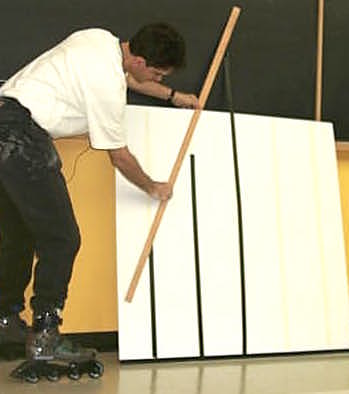Newton's Law of Motion (His second)
Your everyday notion of forces probably includes pushing and pulling and similar actions. Technically, when something is pushed or pulled we say that "a force is applied to the object". What happens to the object when a force is applied? You now know that force isn't the cause of constant motion. Constant motion happens by itself so long as friction or other influences do not bother it. One can say, however, that force can change the motion of something. When an object is at rest, applying a force will cause it to start moving. If something is moving, the right force applied to it can slow it down and stop it.To get more specific about how force affects things, we have to have a way of measuring it. First consider how one can devise a way to apply the same force, reproducibly, time after time, to objects so that we can see what happens under different conditions. For this we can use a spring or elastic band. It appears that the more force that is used to stretch the spring, the farther it stretches. Let's assume that when the same force is applied to the same spring it stretches to the same length. This does not use the length of the spring as a measure of the force. We don't know yet if that would make a good measure of force or not. The only assumption is that the spring stretches the same amount for the same force. Even this assertion may be suspect, but we have to start somewhere.
The spring scales used for lecture demonstrations usually have a big dial with numbers on it. This dial is just showing how far the string inside the scale is stretched. To begin with, we just put a mark on the face and always pull the handle until the needle points to that mark.
The Method
To demonstrate what happens to a body (mine, for example) when a force is applied, I stand on something to reduce friction: skates or a skate board. Then somebody pulls me with the spring scale, trying to keep it at the constant force mark. Thus my assistant tries to maintain a constant force while pulling me along a straight path. During the trip, I will squirt spots on the ground in sync with my famous beeper helmet, once a second. Here is the sort of pattern that is produced.
Below the line of spots is a graph of the line segments between the spots. The segments between consecutive spots are lined up in a row. Because the length of each segment is the distance travelled in one second, the heights of the bars form a bar graph of velocity vs. time. During each second the graph shows that the velocity increases by about the same amount.
Δv ∝Δt
In other words, the velocity-time graph is a straight line.To double the force, I ask the assistant to use two identical scales, hook them both to myself in parallel and pull while trying to keep the pointers of both at the at the same position as during the previous pull. We'll assume that this produces twice the force, though, again this is just a working hypothesis which we will accept if the results make sense. Here is what happens.
This time it looks like the gain in velocity each second is about twice that when pulled by one spring. These two trials are not really enough on which to base a law of physics, but similar experiments have been done under much better conditions. (See for example the film Inertia by E. Purcell.) The conclusion to be drawn is that a constant force causes the velocity to change by the same amount during each interval of time. Double the force and the velocity-change doubles. Mathematically we can write.
Δv ∝FΔt
We might suspect that the amount of velocity change has something to do with the victim. In that case the proportionality constant would vary from object to object as well as with the amount of force. It is possible to rummage around and find another object which has the same velocity change when the same constant force is applied. Then put them both on the skateboard and measure the velocity change per unit time. With two similar sized objects together, velocity change is cut in half. It seems that the more matter there is, the less the same force can change its velocity. Therefore let m represent the property of matter that resists changing its velocity and we write
Rearrange this a little bit:


constant m is called the inertial mass of the body. We will choose to call Δv/Δt acceleration and give it the letter a.
On the graph of velocity vs. time, Δv/Δt is the slope of the curve. If the curve is straight, the acceleration is constant. If the curve isn't straight we have to do the same trick we did before with the position-time graph. Take the slope of the line between two points on the graph and that is the average acceleration between those two times. Let the time interval go to zero, and the line becomes the tangent to the curve and its slope is the instantaneous acceleration. We are just doing the same things we did to the position-time graph to get velocity. When we do the slope trick to the velocity-time graph, it gives us acceleration. 

Putting all this together we can write
or 
F = ma This is one of the most important relationships in physics. I have written that equation in three different ways. You will use it so much that you won't even need to memorize it. You'll just know it.
There is still one big problem. We don't know how to measure F, and we don't know how to measure m. That's the next story.


